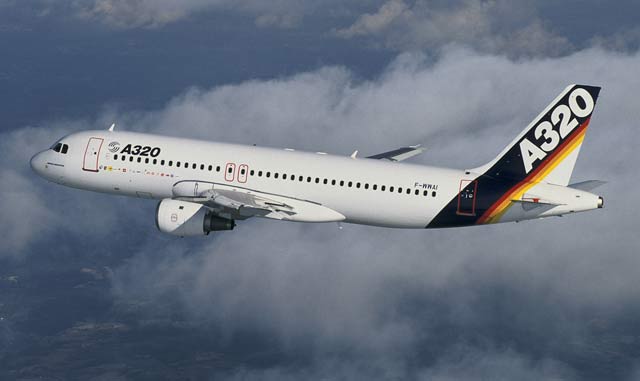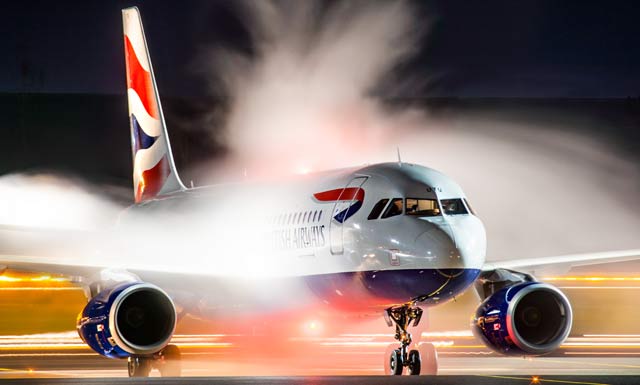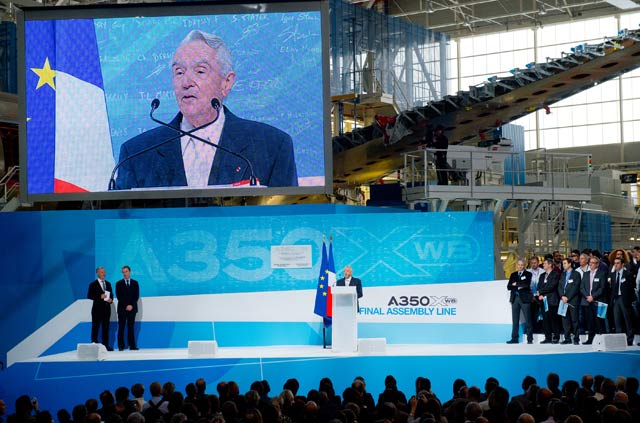As the world’s first digital fly-by-wire (FBW) airliner, Airbus Industrie’s A320 was positioned to bring commercial flying and flight management into the 21st century when it was rolled out in 1987.
The question at the time was: how was 21st century flying going to differ from the way it had been? The question now is: did Airbus get it right?
For Airbus, the A320 was more than just a FBW airliner. It was the still-young company’s debutante in the narrowbody marketplace. But above all – in the company’s strategic perspective – it was its first product in a planned family of FBW airliner types that would, as a result of their control technology, have very similar flying and control-system characteristics.
Nearly 10 years after the A320’s entry into service, by which time the type’s market acceptance was obvious, former Airbus president Roger Béteille admitted the decision to use FBW flight control was one of the most difficult he had ever made. He explained: “Perhaps we were too bold, but we had no choice. Either we were going to be first with new technologies or we could not expect to be in the market."

Livery styles may have changed since 1987, but much of the original aircraft christened by UK royalty lives on
Airbus
From the pilot’s point of view, the fundamental change in the A320 was the addition of flight envelope protection (FEP), which all aviators hope – and most would like to believe – they will never need.
The most visible difference was the replacement of a control yoke with a sidestick. The stick has a relaxed central position such that, when released to it during manual flying, no roll or pitch input is demanded of the pilot.
Control inputs to the sidestick and to the power levers in manual flight are intuitive, even to pilots trained on a mechanically controlled aircraft, but initially it feels strange not to have to follow up a manually commanded pitch change with trim inputs. There are no trim switches, and the conventionally positioned pitch trim wheels on the centre console are not used in flight except as an emergency back-up pitch control system. Pitch change demanded manually via the sidestick is delivered by the elevators, and the act of centring the sidestick commands the stabilisers to trim to the selected flight profile.
In 1997, one of Flight International’s test pilots, Peter Henley, benefiting psychologically from the knowledge that the A320 series had been in successful service for nearly a decade, flight-tested the new A319. He had this to say about flying the aircraft manually: “The sidestick works in the conventional sense and produces a rate of aircraft response which feels right to a pilot accustomed to a conventional aircraft. A comforting feature of the system is that the apparent response to the control and the feel remain constant throughout the flight envelope.”
FEP as a concept was difficult, at first, for flightcrew to get their heads around. In the A320 (and all subsequent FBW Airbuses) it works like this: with its flight control computers selected to normal law, the pilot’s manual inputs, when the aircraft is flying within the flight envelope, are transmitted direct to the control surface actuators unaltered by the computers, so pilots get what they are asking for.
If, however, the pilot allows the aircraft to get close to the edges of the flight envelope, warnings are triggered. If it continues right to the edges, the aircraft will be prevented from stalling, overbanking, overspeeding or overstressing, no matter what the pilot input – or the lack of pilot input, if that happens to be the problem. The FEP also provides an automatic reaction to the effects of windshear.
Meanwhile Airbus’s long term plan – completely visible in the fleet today – is that all FBW Airbuses (that is all Airbus types except the A300 and A310 series) would have so much commonality in terms of human/machine interface and systems control philosophy that for a pilot trained on one of the types, cross-type qualification on the others would be achievable with minimal training time and cost, even across the widebody/narrowbody divide.
FBW as a technology was not a new idea in the early 1980s when the A320 was in gestation. The military had used it extensively, and Airbus’s Toulouse forebear Sud Aviation (later Aérospatiale) had installed analogue computer-driven FBW in Concorde, its supersonic joint venture with British Aircraft Corporation.
To put the Airbus FBW venture into the context of its era, only one other airliner manufacturer was actively considering FBW control. In the mid-1980s, Boeing had proposed a FBW-controlled narrowbody designated the 7J7. It was to be fitted with twin aft-fuselage-mounted unducted fan engines (“propfans”), and intended for service entry in 1992. However, problems with the propulsion technology ultimately defeated the manufacturers, and a propfan has still not been successfully developed.

Popularity of the A320 has been the payoff of an existential choice: be first with new technology or, likely, be out of the market
AirTeamImages
Boeing introduced FBW seven years after the A320’s service entry in its hugely successful 777 widebody, but the company’s direct narrowbody competitor for the A320, the perennially successful 737 series, is still selling well despite having conventional mechanical controls. The 737’s flight deck is just as highly automated as the A320’s in terms of its autopilot/autothrust and flight management system capabilities, but it does not have active flight envelope protection, just warnings and a stickshaker.
The question 30 years after the A320 series’ service entry is: did Airbus get it right? The market says yes, and so do the accident statistics (or lack of them). But have the original flight laws/software that defined the A320’s flying characteristics at service entry in 1988 had to be changed in the light of experience? Soon after entry into service the manufacturer added a low-energy warning to the system, but otherwise the simple answer seems to be no.
Certainly no fundamental changes have been needed, but there have been a few adjustments to take account of higher gross weight or aerodynamically modified versions – like engine nacelle changes. Airbus also admits blandly: “A rotation law has been implemented for better take-off performances. The crosswind landing is made easier thanks to a new decrab law.”
The cockpit in the latest versions looks remarkably similar to the original, but its capabilities have been updated like those of other airliner types over the past 30 years. These updates take account of the drift away from navigating by radio beacons toward global navigation satellite systems. For example, they include precision area navigation, required navigation performance, vertical navigation, autopilot-flown traffic alert and collision-avoidance manoeuvres, runway overrun warning and prevention systems, and electronic flightbags. The company says there have been no changes to its A320neo cockpit.
So, despite all the initial apprehension about the A320’s FBW/FEP systems, they have proved themselves to be remarkably durable.
Cockpit automation
Airbus Industrie’s ambition to design a flight control system that would help pilots do their job better and more safely than purely mechanically connected controls drove it, in the early 1980s, to conduct a fresh examination of how pilots’ roles were changing in the modern commercial aviation environment. The company concluded that pilots would definitely remain essential, that the cockpit design would reflect their primacy as decision-makers, but that also they would need more back-up in the age of highly automated cockpits, busier skies and an expectation of zero accident risk.
The new cockpit automation philosophy first launched in the A320-series anticipated an imminent era when pilots would hardly ever trip the autopilot out, and aircraft could rely largely on flight management systems for navigation, because their computational capabilities, speed and accuracy far exceeded the mental capacity of pilots. These things are taken for granted now, but then they were unfamiliar.
Autopilots combined with autothrottle had long been a useful pilot tool, but they work equally well with FBW or the old mechanical control systems. The latest variant of the venerable 737-series is a good case in point, and it still competes commercially with the A320 series.
There are times, however, when the autopilot – only capable of operating when the aircraft is within its flight envelope – is designed to trip out if it approaches the limits of its operating capability for whatever reason. This is the point where the pilots are expected to take over, using their flexibility, ingenuity and training to take charge of a situation that might be surprising, complex and confusing.
At this point, a glance at 1970s/1980s military control technology can aid understanding of the philosophy behind the extension of FBW capability to encompass FEP. In the 1980s there was direct cross-fertilisation of ideas between the computer-controlled dynamic (CCD) system of the Dassault Mirage 2000 fighter and the Airbus team, some of whom had flown it or military types like it.
CCD, which would now be called FBW with FEP embedded in the software, enabled a combat pilot bent on obtaining maximum performance from the aircraft to be able to demand it at any speed by moving the joystick and throttle on to the stops with no fear of overstress or damage. This liberated the pilot to concentrate on mission tactics, and enabled the airframe to be designed with “relaxed stability” without fear of loss of control, making the aircraft much more manoeuvrable.
FEP keeps the aircraft operating within safe parameters even if the pilot mishandles or neglects to control it, and the full authority digital engine control system does the same for the powerplants.
Airbus’s ultimate reason for moving into digital FBW was that it was now a sufficiently mature technology for use in the commercial arena, and the safety benefits of FEP were so obvious that it simply did not make sense not to use it.
Testing the prototype
In 1984, when Airbus Industrie was flight-testing its FBW system – some three years before the first A320 was rolled out – the manufacturer’s then senior vice-president for engineering, Bernard Ziegler, invited Flight International’s air transport editor David Learmount to take the controls of the FBW testbed A300B2. The aircraft carried the FBW flight computers linked to a single sidestick control that was mounted at the left-hand seat. The right-hand seat pilot had a conventional yoke with mechanical control runs.

Airbus named its A350 assembly line after A320 champion Roger Béteille, speaking
Airbus
In a short pre-flight briefing, Ziegler explained that, although the aircraft might feel as if it was acting in response to a direct connection between the sidestick and the elevators and ailerons, the relationship was more subtle. The spring-loaded sidestick, when relaxed to its central position, commanded – via the flight control computers – a 1g flight profile and a zero roll rate. When displaced in pitch the stick commanded a proportionate change in the vertical acceleration by operating the elevators, but the computers would limit the positive or negative acceleration to the maximum allowable g load if the stick was pushed or pulled on to its stops.
Ziegler explained that sideways stick displacement commanded a proportionate roll rate up to a maximum of 15°/s. And, he added, the system would not let the pilot stall the aircraft. He told his ingénue co-pilot he could try it when airborne.
In the testbed A300, the sidestick’s signals were sent to the computers which, in turn, sent signals that activated control surface servos according to the stick displacement and the flight laws embedded in the system software.
The purpose of this flight was to demonstrate the system’s FEP in action. Learmount took over the sidestick seat when the aircraft was at a safe altitude, Ziegler gave him control and invited him to try to stall the aircraft in clean configuration. The throttles were set to idle, and Learmount chose to let the aircraft slow down in level flight. When the indicated airspeed was approaching the stall at about 100kt (185km/h) the nose began to dip to maintain an angle of attack just above the stall. Learmount pulled the stick back to raise the nose and induce a stall, but the nose continued to dip and the airspeed continued – marginally – to reduce until it reached what Ziegler later explained was “alpha-floor”. This is the stalling angle of attack. At that point, with the stick still fully back on the stops, the engines wound up automatically to take-off/go-around power. As the airspeed increased and the angle of attack was just clear of the stall, the nose began to rise steadily and the aircraft powered upwards out of its brief descent.
The FEP limits the angle of bank more simply: a pilot roll input on the stick simply stops being effective at a maximum of 67° bank. Overspeed protection is provided by raising the nose to keep the speed within flight envelope limits, even if there is nose-down pilot input.
Pilot mental appreciation of how the FBW laws work in practice seems to be just a matter of familiarity. Manual flying in the A320 series feels perfectly intuitive, so it should not matter whether the pilot thinks of a pitch-up displacement of the sidestick as a demand for a proportionate elevator deflection, or as a demand for a proportionate increase in vertical g (which is how the FBW system delivers it), because the effect is identical: the nose-up attitude increases as demanded by the pilot. Likewise, it should not matter whether a pilot displacing the sidestick to the left is demanding a proportionate aileron deflection or a proportionate rate of roll, as the effect is identical.
Having experience not only of developing Airbus’s cockpit automation philosophy but of introducing conventionally trained line pilots to it in the early days, experimental test pilot Etienne Tarnowski remembers how it felt persuading them that the A320 was not taking control away from the pilots and giving it to a computer.
Tarnowski says it was useful to provide them with analogies they were familiar with. Pilots do not complain that yaw dampers or turn co-ordination systems take control away from them, he suggests, but rather see them as assistants. FEP in pitch loading does not take control away from pilots hit by a storm downburst on final approach, but liberates them to pull fully back on the stick knowing it will provide absolute maximum aircraft climb performance without fear of stalling.
Most questions from trainees, says Tarnowski, were not about manual flying or the flight controls, but about getting the most from the flight management guidance computer via the autopilot, autothrust and flight management system: managing the automated systems and choosing the best autopilot modes for any particular phase of flight. This happens to be the same in highly automated cockpits that do not work with FBW/FEP.
Tarnowski believes there would have been an early days benefit for new A320 crews if Airbus had merged its design and training teams earlier in the design process, but says: “I am not convinced that an earlier merging of the test and training communities would have changed the design of the A320.” It would probably have helped the instructors, however.
Source: Flight International





























